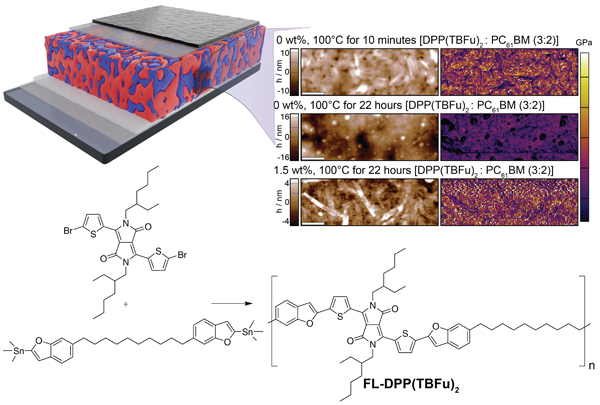Molecular strategies to increase robustness of organic semiconductors for application in photovoltaic and photoelectrochemical devices
Over the past four decades, π-conjugated organic semiconductors have attracted significant attention from both academic and industrial laboratories due to a wealth of potential applications in solution-processed, inexpensive and high performance transistors and photovoltaic devices. More recently, organic semiconductors are attracting increasing attention to application in diverse fields such as bioelectronics and artificial photosynthesis. Thus understanding and improving their robust operation in a variety of challenging environments is a critical task. LIMNO’s research with organic semiconductors revolves around the development of molecular morphology control strategies using conjugation-break spacers, the demonstration compatibilization strategies, and investigations of covalently-linked block and network polymers, which afford tunable charge transport and solvent tolerance—making them promising for application as charge-transport interlayers in all-solution processed devices. In addition, the application of bulk-heterojunctions to artificial photosynthesis via photoelectrochemical water splitting is an emerging topic of strong interest. See the references below for more information.

Representative publications:
Please note that the publication lists from Infoscience integrated into the EPFL website, lab or people pages are frozen following the launch of the new version of platform. The owners of these pages are invited to recreate their publication list from Infoscience. For any assistance, please consult the Infoscience help or contact support.
Fully Conjugated Donor–Acceptor Block Copolymers for Organic Photovoltaics via Heck–Mizoroki Coupling
ACS Macro Letters. 2019. Vol. 8, p. 134-139. DOI : 10.1021/acsmacrolett.8b00932.Please note that the publication lists from Infoscience integrated into the EPFL website, lab or people pages are frozen following the launch of the new version of platform. The owners of these pages are invited to recreate their publication list from Infoscience. For any assistance, please consult the Infoscience help or contact support.
Organic Semiconductor Based Devices for Solar Water Splitting
Advanced Energy Materials. 2018-11-15. Vol. 8, num. 32, p. 1802585. DOI : 10.1002/aenm.201802585.Please note that the publication lists from Infoscience integrated into the EPFL website, lab or people pages are frozen following the launch of the new version of platform. The owners of these pages are invited to recreate their publication list from Infoscience. For any assistance, please consult the Infoscience help or contact support.
Conjugation break spacers and flexible linkers as tools to engineer the properties of semiconducting polymers
POLYMER JOURNAL. 2018. Vol. 50, num. 8, p. 725-736. DOI : 10.1038/s41428-018-0069-z.Please note that the publication lists from Infoscience integrated into the EPFL website, lab or people pages are frozen following the launch of the new version of platform. The owners of these pages are invited to recreate their publication list from Infoscience. For any assistance, please consult the Infoscience help or contact support.
Melt-processing of small molecule organic photovoltaics via bulk heterojunction compatibilization
Green Chemistry. 2018. Vol. 20, p. 2218. DOI : 10.1039/C8GC00335A.Please note that the publication lists from Infoscience integrated into the EPFL website, lab or people pages are frozen following the launch of the new version of platform. The owners of these pages are invited to recreate their publication list from Infoscience. For any assistance, please consult the Infoscience help or contact support.
Amorphous Ternary Charge-Cascade Molecules for Bulk Heterojunction Photovoltaics
Acs Applied Materials & Interfaces. 2017. Vol. 9, num. 33, p. 27825-27831. DOI : 10.1021/acsami.7b04983.Please note that the publication lists from Infoscience integrated into the EPFL website, lab or people pages are frozen following the launch of the new version of platform. The owners of these pages are invited to recreate their publication list from Infoscience. For any assistance, please consult the Infoscience help or contact support.
Enhancing the Thermal Stability of Solution-Processed Small-Molecule Semiconductor Thin Films Using a Flexible Linker Approach
Advanced Materials. 2015. Vol. 27, num. 37, p. 5541-5546. DOI : 10.1002/adma.201501826.Please note that the publication lists from Infoscience integrated into the EPFL website, lab or people pages are frozen following the launch of the new version of platform. The owners of these pages are invited to recreate their publication list from Infoscience. For any assistance, please consult the Infoscience help or contact support.